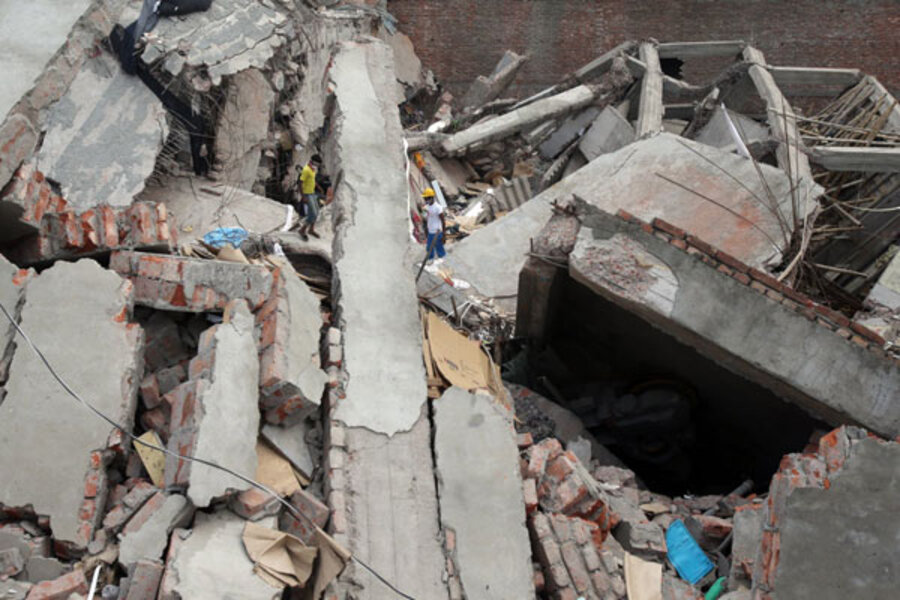Bangladesh united in grief over a failed rescue from collapsed factory
Loading...
| Dhaka, Bangladesh
She was the last person located and known to still be alive inside a garment factory building that collapsed last week in Bangladesh. But before rescuers could save Shahina Akhter, a fire broke out in the rubble today and the woman who captured the attention of the nation perished. The death toll now stands at 378.
Bangladesh is passing through one of its gloomiest national moments. Civilians extending help in the rescue effort were anxiously looking forward to Ms. Akhter's rescue, as were those away from the site, who remained glued to television and mobile phones.
Firefighters made three foxholes in the area where Akhter was stuck and almost managed to get her out. In the meantime, public hope for her rescue led the army to hold off on its plans this morning to start using heavy equipment to clear more of the rubble, according to Masudur Rahman Akand, a deputy assistant director of the Fire Service and Civil Defense.
When the fire broke out, the failure brought tears to the eyes of many. With the fourth day of search and rescue coming to a close, victims are reluctant to give up hope, and a nation remains, for a time, united in grief and anger.
According to information provided by relatives of those who worked in the factories, about 761 persons are still missing. A security guard rescued last night has said that a person on the seventh floor of the squeezed building was still alive.
“There could be few more people still surviving inside the wreckage,” says a local journalist present at the site.
However, preparations are underway to begin the second phase of recovery by using cranes and other heavy equipment. “According to our estimates possibly there is no more persons alive,” says a lieutenant colonel with the Bangladesh Army. “With [only] light equipment we cannot remove all the rubble.”
The rescue efforts have transfixed Bangladeshis, overshadowing the Shahbag protests that began in February to insist on tough punishments for Islamist leaders who committed war crimes during the 1971 war for independence. The protests spawned a broader secular movement, and touched off political tensions about the role of Islam in politics.
For now, those tensions have receded. Bangladeshis from all walks of life, besides extending their support to the rescue efforts, are largely united in calling for the maximum punishment for the owner of the building and the factory owners – for what many call a “mass murder.”
Despite instructions to keep the building closed on Tuesday after an inspection team comprising of engineers identified cracks, the building owner kept it open. Factory owners threatened they would dock workers' pay unless they went to work.
Bangladesh’s elite crime busting agency Rapid Action Battalion on Sunday arrested Sohel Rana, owner of Rana Plaza – the eight-story commercial complex – that housed five factories, a few shops, and a private bank. Mr. Rana was arrested from Benapole, one of the border crossings Bangladesh shares with India.
“All agencies were alerted about Rana. We were finally able to arrest him,” said Mukhlesur Rahman, director general of the Rapid Action Battalion. He had traveled to more than one district in the last four days, he added.
Bangladesh police have also arrested four of the owners of the five factories: Mahmudur Rahman Tapas of New Wave Bottoms, Bazlus Samad Adnan of New Wave Styles, Aminul Islam of Phantom Apparels and Phantom Tac Limited, and Anisur Rahman of Ether Tex.
Yet political disagreements are already on the horizon. Bangladesh’s right-wing opposition Bangladesh Nationalist Party (BNP) has called for a countrywide shutdown on May 2, protesting the deaths at Savar.
A BNP official noted that the day of the factory collapse, the party had called for a nationwide general strike, or hartal, on unrelated matters. Abdul Moyeen Khan, standing committee member of the BNP, implied that workers in the cracked building were forced to come to work in a political bid to prove that people defied the hartal.
“Work was called off the day cracks were identified. What turned so important for the workers to gather during a hartal?” he said.“You must have noticed that several survivors said that they were threatened that their pay will be docked.”
The government is now faced with trying to manage anger from a second major factory disaster within the past half year. In November, a fire broke out in a factory on the outskirts of the capital, killing more than 100 people.
So far, the government has highlighted the rescue efforts as a major success, with as many as 2,400 rescued. Bangladesh Prime Minister Sheikh Hasina said: “This has perhaps never happened in the history that so many lives were rescued after such a disaster.”
[Editor's note: The name of the woman who died is Shahina Akhter. This story adds her last name.]






